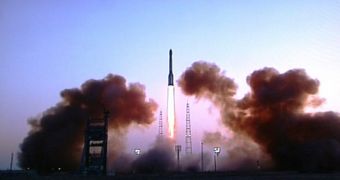The Russian Federation is now the proud owner of another three navigation satellites, which were launched on Thursday aboard a Proton rocket. They will be added to the country's expanding constellation of instruments designed to provide advanced navigation data.
The Glonass network is designed to feature the same advanced capabilities as the American-built Global Positioning System (GPS). Russia desperately wants to enter the market providing such services.
It is not alone in this quest. The European Union and China are also building their own navigation satellite networks, as they want to get out of using the American GPS as well.
As part of the Russian side of the efforts, three new satellites were launched at 0053 GMT Thursday, from the Pad 81 facility at the Baikonur Cosmodrome, in Kazakhstan.
They were delivered to orbit by a Proton rocket, which is the workhorse of the Russian space program.
Less than 10 minutes after the launch, the delivery system injected the three new spacecrafts into their designated circular orbits, at an altitude of 12,000 miles.
The Block DM upper stage of the Proton rocket had to fire two times in sequence to get to this attitude, and to reach an inclination of 64.8 degrees.
The Glonass satellites separated from their carrier vehicle at around 0426 GMT. They are added to another three similar spacecrafts, that were launched on March 1.
According to officials at the Information Satellite Systems Reshetnev Company, the firm that constructed the satellites, each of the new instruments has enough fuel to allow it to remain in orbit for an estimated seven years.
Each craft weighs in excess of 3,000 pounds (1,360 kilograms), and each is based on a modernized Glonass M design. They will be used to broadcast positioning signals for military and civilian applications.
About 21 Glonass satellites are currently functional in orbit, scattered in three orbital groups. With a total of 24 satellites, the network can achieve global coverage, Space reports.
Additional spacecrafts are due to launch this December, from the Plesetsk Cosmodrome. The new satellites will apparently be able to endure for up to 10 years in low-Earth orbit (LEO).

 14 DAY TRIAL //
14 DAY TRIAL //